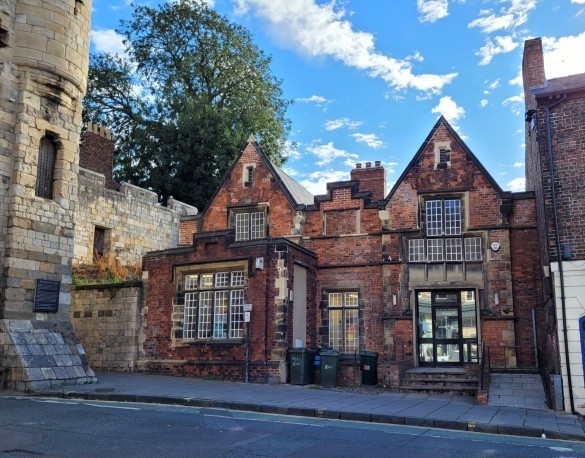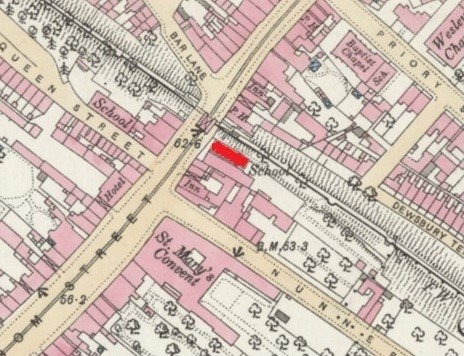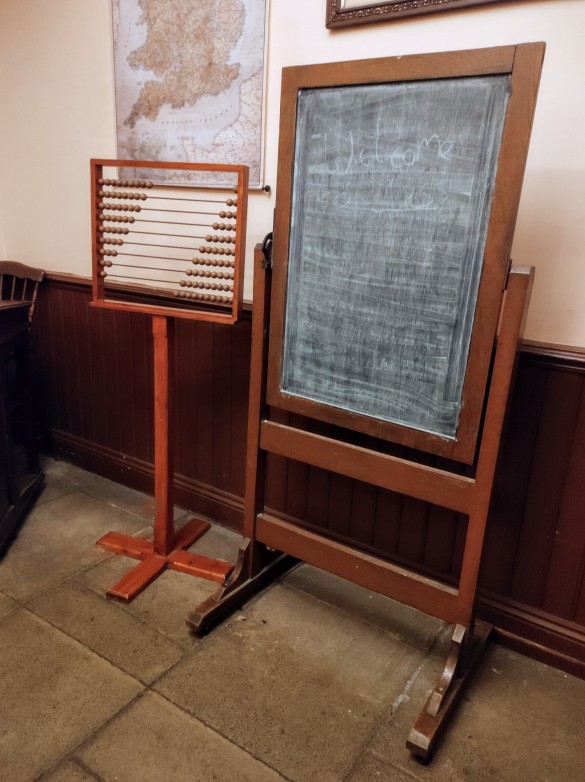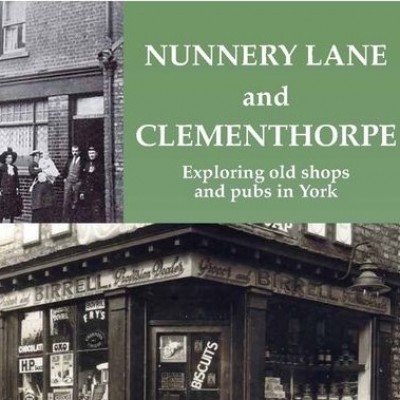York waifs and strays: Ina and Nancy Dixon go to Micklegate School
Ina and Nancy Dixon were deserted by their parents and started their education in the York Poor Law Union Workhouse. They were lucky in having a good teacher, Miss Emily Smith, who was praised in all her HMI annual inspections. Generally workhouse schools had great problems keeping their teachers, as the pay was poor and the duties endless, so the children’s schooling could be erratic.
However, a workhouse was a dismal place for a child to grow up in, and in 1881 the Poor Law Union started boarding out deserted children and orphans. Ina and Nancy were boarded out with William and Selina Clarkson (see York waifs and strays: Ina and Nancy Dixon are boarded out) and moved to the Knavesmire. They attended the Micklegate Schools until they were old enough to leave, Ina from 1881-88 at Micklegate Girls’, and Nancy from 1881-83 at Micklegate Infants and from 1883-89 at Micklegate Girls’.

Micklegate School today, now Changing Lives.
Micklegate was a National School, supported by the Church of England, and the local clergy played an admirable part in the children’s religious education. Unfortunately, the rest of the curriculum was not so good and the 3 R’s (Reading, Writing, ‘Rithmetic) were criticised in most of the annual inspections. Subjects prompted some very forthright comments by HMI Inspectors – “Grammar is absolutely worthless” [1885].
Only needlework was consistently good, a stroke of luck for Ina, as she was good at sewing and became a dressmaker when she left school. Nancy’s favourite subject was probably poetry, which was often stirring and sentimental, such as the tragedy of Prince Llewellyn and his faithful wolfhound. It is tempting to speculate that this is why she later named one of her sons Eric Llewellyn.
A feeling for words and poetry seemed to run in the Dixon family, and two of the other sisters, Jenny and Lila published lyrics to popular songs in later life in spite of an even worse education than Ina and Nancy. They had frequent brushes with the School Attendance Officer and Jenny and another sister, Louie, were eventually sent to the Hull Industrial Girls’ School.
The school had a major problem with absenteeism. Illness, unsuitable clothing for bad weather, no money for fees, etc were understandable reasons for children missing school. There was less excuse for children who truanted every time something exciting happened in York, from the Bishophill Flower Show to the York Races. Sunday school trips and works outings were organised during school hours, a sore point with the School Attendance Officer.
In 1887, a new Headmistress, Miss Jane Wright, pulled the school back into shape, so Ina and Nancy’s last few years were more profitable. The following account is based on the school logbooks. We've noted various entries from these here: Micklegate School logbooks, selections from the 1880s.
Micklegate Infants’ and Girls’ Schools in the 1880s
In August 1881, soon after they were boarded out with the Clarksons, the family moved to the Knavesmire and Ina and Nancy were registered at Micklegate School – Infants for Nancy, and Girls’ for Ina. Ina stayed till 1888, and Nancy till 1889.
Micklegate School was founded pre-1847 in a private house, but moved in 1853 to a building just outside Micklegate Bar until it closed in 1956. The building still exists but is now used by Changing Lives.
It was a National School, so founded by the National Society for Promoting the Education of the Poor in the Principles of the Established Church in England and Wales, and Church of England clergy played a very active role in the life of the school. The Infant School was mixed, but the upper school was for girls only. (There was also a boys’ school from 1835 in separate premises on Queen Street.)
 Map OS CLXXIV.10, Surveyed: 1889, Published: 1892 Reproduced with the permission of the National Library of Scotland, https://maps.nls.uk
Map OS CLXXIV.10, Surveyed: 1889, Published: 1892 Reproduced with the permission of the National Library of Scotland, https://maps.nls.uk
Sadly, the quality of education was not very high. Comments from the annual inspection by Her Majesty’s Inspector of Schools include:
-
Reading, writing and spelling are very fair but arithmetic is poor [1881]
-
Arithmetic is as backward as ever [1882]
-
A heavier fine will have to be inflicted on account of Arithmetic if there is no improvement [1883]
-
Reading is fair, but all the rest of the elementary work is weak, and, Grammar is absolutely worthless [1885]
-
The school is “sadly neglected … in a miserably low state of efficiency.” [1886]
The only subject which was consistently good was Needlework, which benefited Ina. She was good at needlework and earned a living in adult life as a dressmaker. These inspections were not just box-ticking exercises. Schools could be fined for poor teaching, or given grants for subjects which were particularly good.
It was not easy teaching at Micklegate School. There were around 150 children on the roll, and they were all taught in a single room. HMI Inspectors often commended the teachers on maintaining discipline under such difficult conditions. Another room was eventually added in 1885, but unfortunately did not lead to much improvement educationally.
The cramped conditions were eased by the huge absenteeism problem. There were endless reasons for the girls to miss school. The logbooks frequently mention illness – measles, sore throats and scarlet fever in particular. In November 1884 some of the girls attended the funeral of one of their classmates, Laura Potter who died of scarlet fever. Not all children had footwear suitable for bad weather. The children truanted in droves every time something exciting was happening in York, and there was no shortage of events - the Races, St Nicholas’ Fair, the Yorkshire Gala, the Yeomanry Review, Bishophill Flower Show etc – and Sunday School and works outings were often organised on school days, a very sore point with the School Attendance Officer. Ina and Nancy may have been happy participants on a day trip to Scarborough for railwaymen’s families.
Education was not free and cost one or two pennies per week, according to the age of the child. The Poor Law Union paid for Ina and Nancy, but other families could struggle to find the money. The School Attendance Committee was sympathetic and often helped out. In October 1887, they paid fees for 156 applicants. However, there were still logbook entries to the effect that: Two girls left on account of being sent home for their school money.
The curriculum covered the “three R’s” – Reading, writing and ‘rithmetic. It was livened up by “object lessons”, based on a sample of a product or material, and “animal lessons” based on pictures. Subjects covered during the 1880s included: coal, silver, lead, bread, butter, tea, AND, the cat tribe (lion & tiger), the dog tribe (fox, wolf), cow, deer, sheep, etc.
 Poetry was also enjoyed, and often learnt by heart. The younger children had sweet little topics like “The children’s flowers” and “White pussy” but the older ones had stirring tales of pirates (“The Inchcape Rock”) and dramatic historical events (“Caractacus at Rome”, or “Casabianca” whose first line – “The boy stood on the burning deck” – led many irreverent parodies.) Particularly heart-rending was the tragic story of Prince Llewellyn and his wolfhound Gelert, which I suspect was behind the name of Nancy’s son, Eric Llewellyn.
Poetry was also enjoyed, and often learnt by heart. The younger children had sweet little topics like “The children’s flowers” and “White pussy” but the older ones had stirring tales of pirates (“The Inchcape Rock”) and dramatic historical events (“Caractacus at Rome”, or “Casabianca” whose first line – “The boy stood on the burning deck” – led many irreverent parodies.) Particularly heart-rending was the tragic story of Prince Llewellyn and his wolfhound Gelert, which I suspect was behind the name of Nancy’s son, Eric Llewellyn.
Blackboard and abacus from Castle Museum
There was also a good dose of a fourth R – religion. Local clergymen visited regularly to teach Scripture and the Catechism, sometimes also helping out with arithmetic or writing. The children may also have had fun singing, as one of the visitors, Joseph Metcalf, Rector of Bilborough, was an authority on rounds, and a co-author of The school round book. The school acquired a harmonium in January 1887. Henry Toovey, the Diocesan Inspector visited annually, and his comments reveal his sympathies towards the children:
-
The children are bright and intelligent [1882]
-
Repetition was well known, singing pleasing and children very neat and orderly [1883]
-
The little children are carefully and kindly taught … They sang their hymns nicely and were orderly and attentive [1884]
-
1887 was perhaps not quite such a good year, as “Division II confused the early lives of Moses and Our Saviour.”
Eventually a new Headmistress, Miss Jane Wright, was appointed at the end of 1887 and the school gradually improved. A year later HMI noted “an appreciable improvement all round”. Needlework earned a higher grant, and English a lower one.
Sources
https://www.british-history.ac.uk/vch/yorks/city-of-york/pp440-460#h3-0036
Crockford’s Clerical Directory, 1885. www.ancestry.co.uk
Girls’ School admissions register. York Explore (Microfilm Collection), and, www.findmypast.co.uk NB In both locations it has been labelled Haxby Girls’ School. I think this is a mistake because:
|



